As you may have suspected from the pages on this blog, I’m rather partial to a bit of cheese. It would in fact be fair to say that barely a day goes by when I don’t eat cheese (today I have macaroni cheese for lunch, yesterday I had it in a salad at lunch and in canapés in the evening, the day before dinner involved a cheese course(!) and the day before that I enjoyed some in a galette – I won’t go on for fear of boring you but the trend continues…).
This love of cheese has not gone unnoticed by those around me (I received some wonderful Welsh cheeses as a present at Christmas which I scoffed before I could blog about them) and on a recent trip to Austria I was taken to a local market by some friends to sample the various wares. After consuming an entire meals worth of tasters I finally left with five different Austrian cheeses, an Italian cheese and some sausage (for a little variety).
And so onto the cheeses that I bought (the names/origins of these may or may not be completely correct – I really should have written the details down on each piece rather than trying to remember it all!)
The red wine cheese – Laendle Weinkaese:
This is a hard cows milk cheese which was washed with red wine as it matured. According to the internet (http://www.vmilch.at/en/laendle-weinkaese) the washing is done twice a week and the cheese is matured for 4 months.
You could really smell the grapes when sniffing this cheese; it had a very clear fruity whiff about it. In terms of the taste it had a mild and general fruitiness which reminded me of comte. I think this is a really nice around snacking cheese, good to nibble by itself or use in a sandwich.
The plastic one – Murtal Styrian Cheese (Murtaler Steirerkäs):
A Styrian delicacy, this was a very unusual cheese. It’s an acid-cured cooked cheese made from cows milk and flavoured with caraway. Because acidic bacteria are used instead of rennet to curdle the milk the cheese has quite a sour taste. During the cooking stage that comes next most of the curds melt (some pieces still remain whole in the cheese) and this gives it a fake plastic texture which is closer to a cheese slice than mozzarella or halloumi (the only other cooked cheeses I know). The caraway adds a really spicy note which I loved, but because of the fairly strong sour flavour I couldn’t eat a lot of this in one go. Great in small doses but not something to make a meal of for me.
The one from the Silver Mine – Stollenkase:
Another hard cows cheese, this one is matured 100m underground in an old Silver Mine in Arzberg (http://www.almenland-stollenkaese.at – they also make a red wine washed variety!). The temperature down the mine is a constant 10C whatever time of year it is and the cheese are left exposed to the elements and then washed gently with salt water. This was a bit stronger than the red wine cheese, not as soft overall with the slight acid astringency you get with a mature cheddar. Another really nice cheese though for picking at!
The blue one – Blue goats cheese:
I have to confess that I have completely forgotten the proper name for this cheese, and the internet is not proving very helpful. I do however remember that it’s a blue cheese made with milk from mountain goats (not just any old goats – mountain goats!). It had a fairly soft almost frothy texture making it easy to cut and interesting in the mouth. I’m a big fan of both goats cheese and blue cheese so I loved this. It was fairly mild and goaty to start with but had a massive blue tang on the back of the throat that hung around for ages.
The garlic one – Brie with garlic and herbs:
Once again the proper name for this has unfortunately escaped me. However the English translation I was given was brie with garlic and herbs. I have to be honest and say that on the herb front I couldn’t taste that much, but they definitely weren’t lying about the garlic! When you smell this or first put it in your mouth it doesn’t seem that strong, but once you chew that garlic really kicks in. And the more you chew, the more intense that garlic flavour gets. A very powerful cheese indeed!
The odd one out – Italian chestnut cheese (Occelli ® in foglie di Castagno – http://www.occelli.it/en/47-occelli-in-foglie-di-castagno):
While I was primarily after Austrian cheeses, one of the stalls suggested that I try this and I’m very glad I did. It’s like no cheese I’ve tried before! It’s a mixture of cow, sheep and goats milk (with the mix depending on availability) which is matured for a year and a half and then wrapped in chestnut leaves for extra flavour.
It was an extremely flaky cheese, I didn’t have a slice so much as a collection of small pieces, yet in the mouth the texture was extremely soft and creamy (increasing so with the pieces from closer to the edge that had been wrapped) as opposed to dry and hard which I would have expected given its appearance. There was a strong hint of goat about this cheese, but I guess that would change depending on batch you had. It also had a earthiness and woodiness that I really liked.
So there you go, an awful lot of cheese, all of which I had to cram into my hand luggage! I’ve really enjoyed devouring these since I’ve been back. I have no idea if it’s possible to source any of these cheeses elsewhere, but if not have a look out for them if you’re ever in Austria.
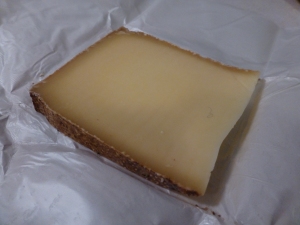
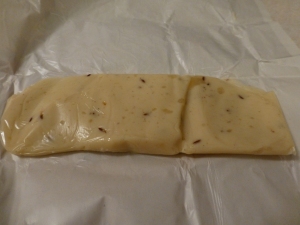
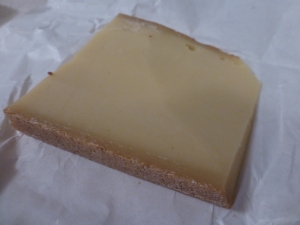
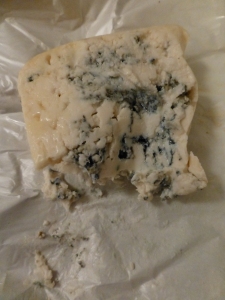
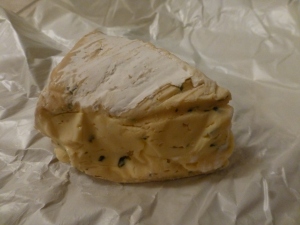
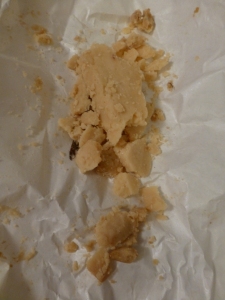
As a fellow fan of cheese, these do look delicious. Great post.
Yum, looks like a great selection. Which was your favourite?
From the Austrian ones the Goat’s blue was my favourite, I love a strong blue and I love goats cheese so that was a brilliant mix. Overall I think the Italian chestnut one was my favourite just because it was so unusual. I’ve never tried anything like it before.